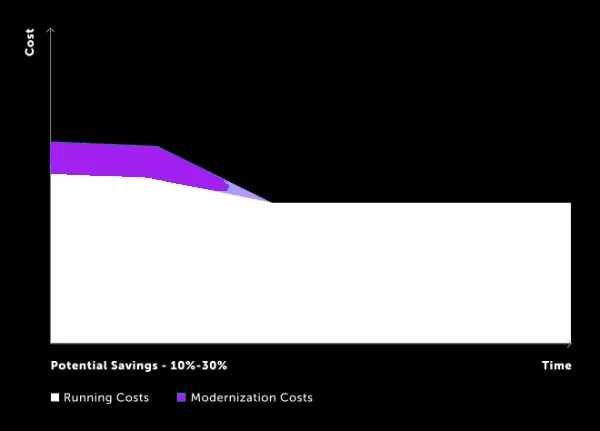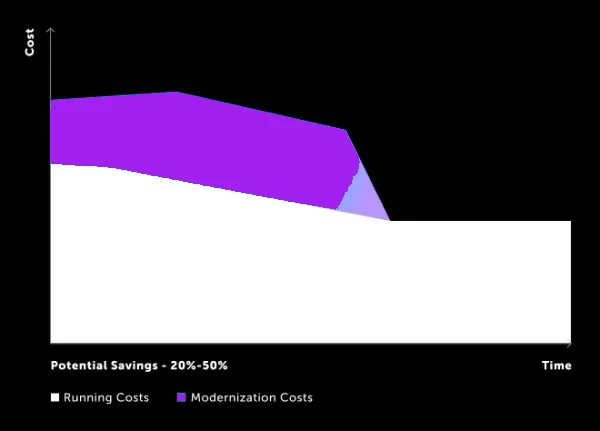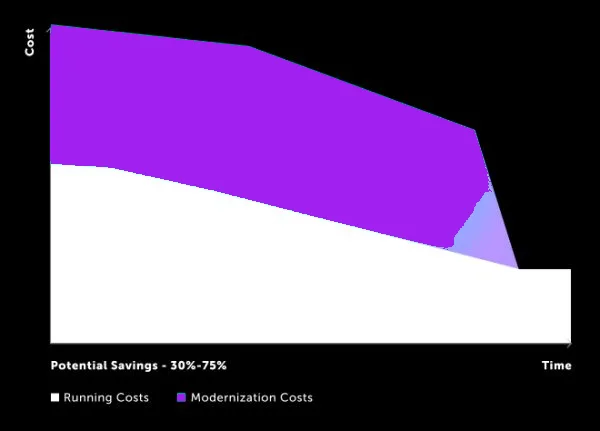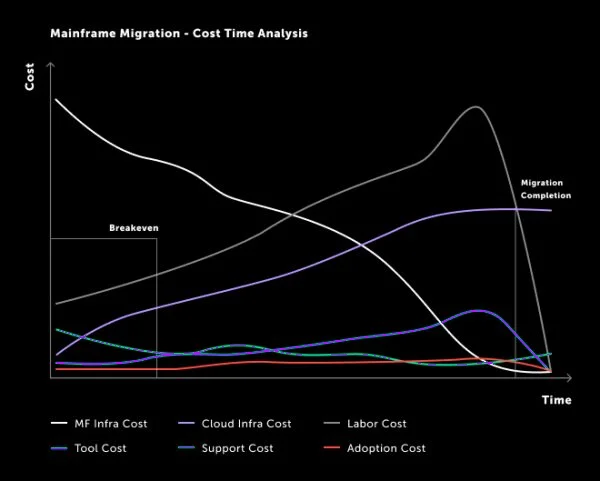Table of content
For many years, mainframes served as the backbone of enterprise IT, enabling exceptional mission-critical workloads, unparalleled dependability, and centralized management across the most tech-sensitive industries.
However, over time, the very advantages of mainframes fade. Mainframes are becoming expensive anchors rather than innovation accelerators, with snowballing issues. As a result, businesses opt for cloud-native, open-source, and distributed systems, scalable, reliable, and easy to maintain. Therefore, migration becomes a financial plan with massive return on investment (ROI) potential, rather than a technological update.
This material delves into the quantifiable results of legacy modernization and guides you through the legacy modernization examples. No minute wasted, let’s get down to the point.
The Cost of Legacy Systems
Often, legacy systems hide additional costs which being revealed, proving that modernization is a cost-effective decision. The main cost drivers of legacy environments include:
- Escalating Operational Costs: In many cases, businesses spend up to 100% more on average on obsolete licensing, maintenance, and narrow-expertise hiring costs,
- Lack of Specialized Skills: Legacy skill sets such as COBOL and PL/I are becoming more and more costly,
- Barriers to Integration: Innovation is slowed by legacy systems that were never built for cloud, APIs, AI/ML pipelines, or DevOps.
- Cloud Migration Hurdles: IT operating expenses can be reduced by 60–90% by moving from mainframes to cloud environments.
Simply put, modernization is a cost-control and growth-enabling strategy rather than merely a technological choice.
Common Cost Patterns via Modernization Approaches
Seeking to modernize legacy systems? Three primary modernization strategies dominate the market in terms of cost.
Rehosting (or “Lift-and-Shift” Strategy)
According to this method, the businesses transfer current mainframe applications as a whole, without any changes in the architecture, coding, or data model, to a cloud-hosted environment. The major plus is no downtime risk while swiftly moving code untouched. As a result, rehosting is frequently selected when:
- Due to growing expenses or expiring vendor contracts, the company must swiftly leave the mainframe platform,
- There is no imminent need for functional improvements because the business logic is sound,
- Rather than modernizing applications, the emphasis is on preserving infrastructure.
Because rehosting eliminates costly and time-consuming code reworking, it offers the lowest upfront cost and the quickest migration period from a return on investment standpoint. However, the Integration with contemporary, cloud-native services may be difficult, and the moved system may still have inefficiencies from the mainframe era.
That’s why rehosting is frequently used as the initial stage in a multi-phase modernization process by many enterprises, which first stabilizes infrastructure and costs before moving on to replatforming or refactoring for greater agility, scalability, and performance.
Replatforming
Replatforming keeps the essential application architecture and data model while moving current mainframe applications to a contemporary runtime environment. It could be a cloud-based or distributed on-premises platform.
In contrast to rehosting, this approach implies altering the codebase to support a new database, operating system, and compilers without significantly altering the application’s business logic. This legacy modernization strategy works best for companies that:
- Want to enhance integration with contemporary ecosystems (APIs, cloud services, DevOps pipelines) while decreasing reliance on mainframes,
- Have applications that work reliably but require improved performance or scalability,
- Try to balance the modernization advantages, risks, and expenses.
Though replatforming is harder, longer, and more expensive than rehosting, since it requires some code modifications, testing, and potential database migrations. However, replatforming frequently results in considerable operating expenditure (OPEX) savings, improved speed, and simpler interaction with cloud-native applications, becoming a middle ground in many modernization roadmaps.
Refactoring and Re-architecting
The most cardinal mainframe modernization type is refactoring and re-architecting. These strategies entail complete changes in cloud-native architectures and services, streamlining almost every aspect with the same business logic.
The overall goal is to improve the system’s scalability, performance, maintainability, and integration capabilities in addition to moving away from the mainframe. This frequently indicates:
- converting old code into more contemporary languages like Java, C#, or Go,
- switching to modular or microservices-based architectures from monolithic ones,
- optimizing databases (SQL/NoSQL, managed cloud databases) for cloud or distributed systems,
- combining serverless functions, containerization (Docker/Kubernetes), and DevOps pipelines,
- utilizing real-time data processing, advanced analytics, and AI/ML services, and more.
Of the three modernization techniques, this one requires the largest initial investment because of the substantial work scope. However, the ROI potential is as big as the challenges. Refactoring is frequently selected when:
- The current application is too rigid to change to meet evolving business needs,
- One of the main priorities is integration with contemporary digital ecosystems,
- Over the next five to ten years, the firm wants to be as agile and cost-effective as possible.
To lower the risk of downtime, companies frequently refactor in stages, starting with core modules, testing out new architectures, and then progressively overhauling the whole application portfolio step-by-step.
How Costs Change while Mainframe Refactoring and Rearchitecting with Time
When evaluating ROI, it’s essential to understand the shifting cost landscape pre- and post-migration. We have compared the most valuable metrics and shown how they change throughout the modernization process.
Decreased Mainframe Infrastructure Costs
The MIPS (million instructions per second) metric is frequently used to calculate mainframe pricing. As workloads move to distributed systems, migration drastically lowers these costs. Other pricing models include:
- Peak consumption charging is based on the Rolling 4-Hour Average (R4HA),
- Subcapacity Pricing: only pay for the actual amount of use,
- Pay for the entire capacity with full-capacity pricing,
- Performance-based pricing that is correlated with transaction volume,
- Subscription Models: annual or fixed monthly fees.
As a result, post-migration, the mainframe hosting, licensing, and maintenance expenses decrease by as much as 50–90% per year. This is impressive, isn’t it?
Rising Cloud Infrastructure Costs
Cloud services replace mainframe costs but are lower and more stable. Cloud services legacy systems example:
The average annual cost per installed MIPS for a big mainframe system with more than 11,000 MIPS is about $1,600. This comprises the costs of hardware and legacy software examples, which normally make up roughly 65% of the overall cost, or about $1,040 per MIPS annually.
An 11,000 MIPS machine, for example, may cost roughly $17.6 million a year at this rate (11,000 × $1,600), potentially saving 50–90% in the long term.
Volatile Labor Costs
Skilled teams are essential for fruitful migrations: for testing, code conversion, and migration during modernization. So pricing often varies depending on the team and hours, including:
- Size of Code (LOC): More lines bring more effort,
- System Complexity: Dependencies and integrations extend the timeframes,
- Legacy Languages: COBOL/PL-I proficiency needs an extra price,
- AI-Powered Automation: Smart tools reduce 20–40% of manual labor,
But keep in mind that after the transition, costly mainframe specialists are replaced by smaller, cloud-savvy teams.
Increasing Adoption Costs
Long-term ROI efficiency depends on training. Teams must be proficient in DevOps techniques, cloud services, and contemporary languages. The adoption costs formula includes the following:
Training Costs = (Employees × Training Hours × Cost per Hour) + External Trainer Fees + Training Tools + Post-Training Support
After the first year, these expenses drastically drop as skills become ingrained.
Stable Tool Costs
The businesses also need specialized tools for code analysis and conversion. This way, the costs significantly vary depending on the models of licensing, feature set like cloud integration and AI capabilities, and the needs for scalability and customization. Moreover, you need to consider the following factors while choosing a tool:
- Compatibility with target platforms and legacy languages (PL/I, Natural, and COBOL),
- Automation features,
- Comprehensive support from vendors,
- Cost efficiency.
Additionally, during migration, tool expenditure is upfront. However, later, it drops due to less expensive open-source or subscription models.
Steady Post-Migration Maintenance Costs
Support costs are frequently higher in the early phases of mainframe modernization:
- Parallel Environments: While running both new and old systems, you need more resources on both,
- Knowledge Transition: Problem solving drops as teams only get acquainted with the new tools, processes, and infrastructure,
- Vendor Support: Sometimes, when vendors’ support is needed, this would raise the immediate cost.
Over time. these costs start to go down:
- Managed Services: Large in-house support teams are redundant when maintenance and monitoring are outsourced to specialized suppliers,
- Advanced Monitoring Tools: The more intelligent monitoring tools you use, the less likely the costly downtime is,
- Cloud-Native Automation: Automated patching, auto-scaling, and auto-healing reduce operational overhead and manual intervention.
- Simplified Workflows: Integrated toolchains and unified platforms remove pointless steps.
In the long run, businesses benefit in all aspects. They enjoy quicker incident resolution, increased uptime, and more effective resource allocation in addition to predictable, cheaper support expenses.
How to Cut Post-Migration Costs?
Modernization done right opens up several cost-cutting levers:
- Mainframe decommissioning completely removes MIPS expenses,
- Smaller staff means the cloud-native knowledge is more affordable and accessible,
- Pay for actual usage solely with elastic scalability,
- Process automation lowers errors and speeds up releases.
To sum up, through proper modernization techniques, businesses anticipate yearly OPEX savings of 50–90% while increasing their capacity for innovation, scalability, and agility, according to industry experience.
Modernization as a Strategic Investment
Modernizing mainframes is an investment in agility, scalability, and innovation rather than only cutting costs. Although there are initial costs associated with the examples of legacy systems, there will be significant long-term benefits, including reduced OPEX, shorter delivery cycles, and a competitive edge.
Want to ensure a seamless transition with high ROI? Contact us for implementing a staged migration strategy, utilizing automation, and concentrating on change management. Let’s talk.
Frequently Asked Questions
-
How long does it take to see ROI from mainframe modernization?
After migration, most firms begin to see some shifts in ROI within 12 to 24 months, depending on the project complexity, the strategy type, and the adoption rate.
-
Is refactoring always the most cost-effective approach?
Not necessarily. Although the newest legacy system modernization case study shows it requires a significant investment, refactoring provides the greatest agility and long-term savings. For shorter-term objectives or simpler workloads, rehosting or replatforming is more economical.
-
What’s the biggest cost driver in modernization projects?
The biggest share of expenses is for labor. While automation greatly minimizes manual intervention, migration still requires specific knowledge, which could be costly.
-
How can we minimize disruption during migration?
Effective change management, parallel run environments, comprehensive testing, and phased migrations all contribute to business continuity.
-
Are cloud costs guaranteed to be lower than mainframe costs?
Not always. Poor workload planning or ineffective architectures result in overspending, even if cloud pricing models are insignificant. It’s crucial to monitor consumption and properly size resources.
















